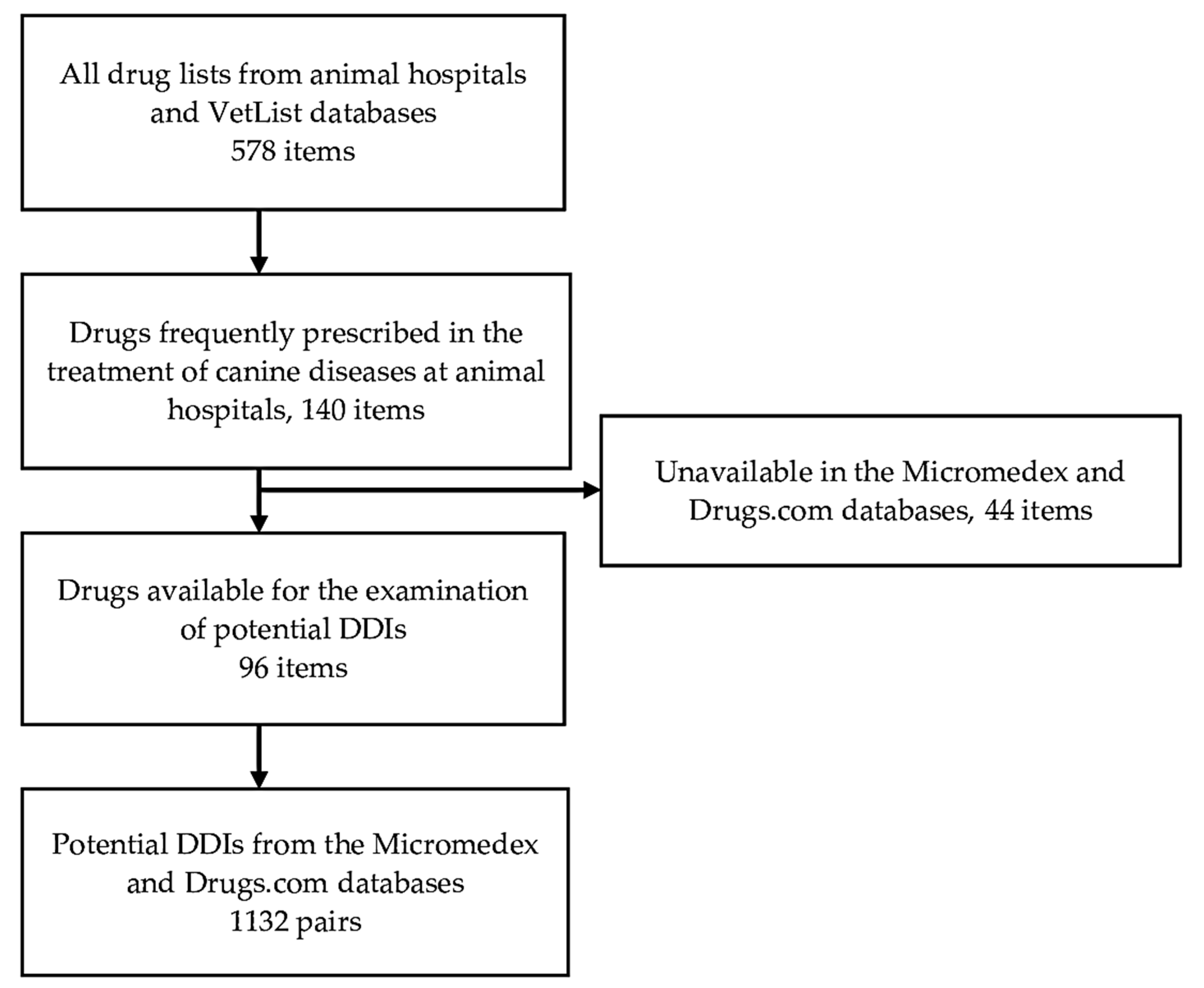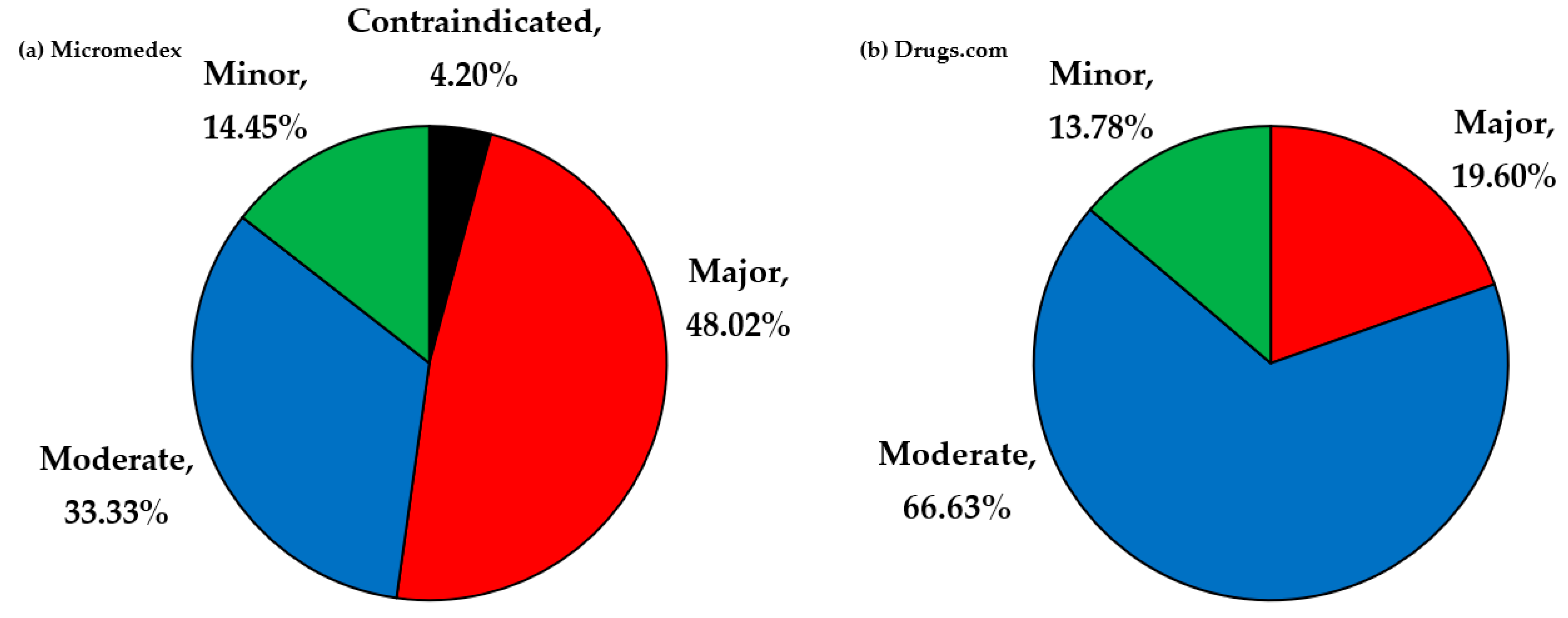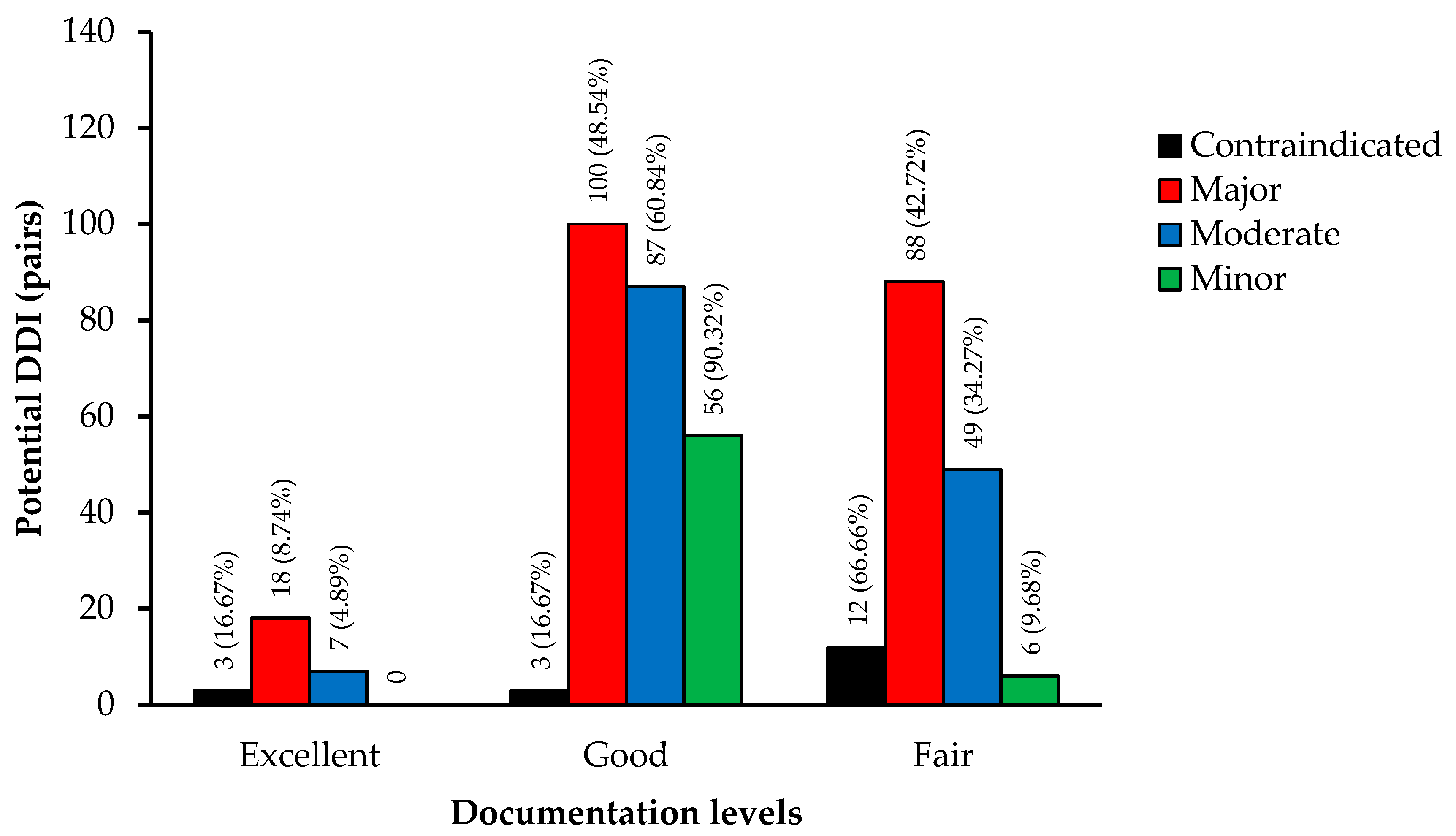Comparing Potential Drug–Drug Interactions in Companion Animal Medications Using Two Electronic Databases
Abstract
:1. Introduction
2. Materials and Methods
2.1. Drug Selection
2.2. Drug Interaction Database Selection
2.3. DDI Categorization
2.4. Data Analysis
3. Results
4. Discussion
5. Conclusions
Supplementary Materials
Author Contributions
Funding
Institutional Review Board Statement
Informed Consent Statement
Data Availability Statement
Acknowledgments
Conflicts of Interest
References
- Ersoy, S.; Engin, V.S. Risk factors for polypharmacy in older adults in a primary care setting: A cross-sectional study. Clin. Interv. Aging 2018, 13, 2003–2011. [Google Scholar] [CrossRef] [PubMed] [Green Version]
- Menditto, E.; Gimeno Miguel, A.; Moreno Juste, A.; Poblador Plou, B.; Aza Pascual-Salcedo, M.; Orlando, V.; Gonzales Rubio, F.; Prados Torres, A. Patterns of multimorbidity and polypharmacy in young and adult population: Systematic associations among chronic diseases and drugs using factor analysis. PLoS ONE 2019, 14, e0210701. [Google Scholar] [CrossRef] [PubMed] [Green Version]
- Boostrom, B.O.; Moore, A.S.; DeRegis, C.J.; Robat, C.; Freeman, K.; Thamm, D.H. Canine Cutaneous Plasmacytosis: 21 Cases (2005–2015). J. Vet. Intern. Med. 2017, 31, 1074–1080. [Google Scholar] [CrossRef] [Green Version]
- Cornelis, I.; Van Ham, L.; Gielen, I.; De Decker, S.; Bhatti, S.F.M. Clinical presentation, diagnostic findings, prognostic factors, treatment and outcome in dogs with meningoencephalomyelitis of unknown origin: A review. Vet. J. 2019, 244, 37–44. [Google Scholar] [CrossRef]
- Roblek, T.; Vaupotic, T.; Mrhar, A.; Lainscak, M. Drug-drug interaction software in clinical practice: A systematic review. Eur. J. Clin. Pharmacol. 2015, 71, 131–142. [Google Scholar] [CrossRef]
- Royaux, E.; Bhatti, S.; De Cock, H.; Van Ham, L.; Kitshoff, A.; Vandenabeele, S. Cutaneous adverse drug reaction in a dog associated with imepitoin. Vet. Dermatol. 2016, 27, 118–121.e32. [Google Scholar] [CrossRef] [PubMed]
- Spurlock, N.K.; Prittie, J.E. A review of current indications, adverse effects, and administration recommendations for intravenous immunoglobulin. J. Vet. Emerg. Crit. Care 2011, 21, 471–483. [Google Scholar] [CrossRef]
- Askari, M.; Eslami, S.; Louws, M.; Wierenga, P.C.; Dongelmans, D.A.; Kuiper, R.A.; Abu-Hanna, A. Frequency and nature of drug-drug interactions in the intensive care unit. Pharmacoepidemiol. Drug Saf. 2013, 22, 430–437. [Google Scholar] [CrossRef]
- Dechanont, S.; Maphanta, S.; Butthum, B.; Kongkaew, C. Hospital admissions/visits associated with drug-drug interactions: A systematic review and meta-analysis. Pharmacoepidemiol. Drug Saf. 2014, 23, 489–497. [Google Scholar] [CrossRef] [PubMed]
- Reimche, L.; Forster, A.J.; van Walraven, C. Incidence and contributors to potential drug-drug interactions in hospitalized patients. J. Clin. Pharmacol. 2011, 51, 1043–1050. [Google Scholar] [CrossRef] [PubMed]
- Rainger, J.; Baxter, C.; Vogelnest, L.; Dart, C. Seizures during medetomindine sedation and local anaesthesia in two dogs undergoing skin biopsy. Aust. Vet. J. 2009, 87, 188–192. [Google Scholar] [CrossRef] [PubMed]
- Perez Jimenez, T.E.; Kukanich, B.; Joo, H.; Mealey, K.L.; Grubb, T.L.; Greene, S.A.; Court, M.H. Oral Coadministration of Fluconazole with Tramadol Markedly Increases Plasma and Urine Concentrations of Tramadol and the O-Desmethyltramadol Metabolite in Healthy Dogs. Drug Metab. Dispos. 2019, 47, 15–25. [Google Scholar] [CrossRef] [PubMed] [Green Version]
- IBM Micromedex Database. Drug Interactions. Available online: http://www.micromedexsolutions.com/micromedex2/librarian/ (accessed on 9 January 2020).
- Drugs.com Database. Drug Interactions Checker. Available online: http://www.drugs.com/drug_interactions.html (accessed on 9 January 2020).
- Kheshti, R.; Aalipour, M.; Namazi, S. A comparison of five common drug-drug interaction software programs regarding accuracy and comprehensiveness. J. Res. Pharm. Pract. 2016, 5, 257–263. [Google Scholar] [CrossRef]
- Patel, R.I.; Beckett, R.D. Evaluation of resources for analyzing drug interactions. J. Med. Libr. Assoc. 2016, 104, 290–295. [Google Scholar] [CrossRef] [PubMed] [Green Version]
- Clauson, K.A.; Marsh, W.A.; Polen, H.H.; Seamon, M.J.; Ortiz, B.I. Clinical decision support tools: Analysis of online drug information databases. BMC Med. Inform. Decis. Mak. 2007, 7, 7. [Google Scholar] [CrossRef] [Green Version]
- Shields, T. Animal Drugs@FDA. J. Med. Libr. Assoc. 2009, 97, 158. [Google Scholar] [CrossRef]
- Apidi, N.A.; Murugiah, M.K.; Muthuveloo, R.; Soh, Y.C.; Caruso, V.; Patel, R.; Ming, L.C. Mobile medical applications for dosage recommendation, drug adverse reaction, and drug interaction: Review and comparison. Ther. Innov. Regul. Sci. 2017, 51, 480–485. [Google Scholar] [CrossRef]
- Marcath, L.A.; Xi, J.; Hoylman, E.K.; Kidwell, K.M.; Kraft, S.L.; Hertz, D.L. Comparison of nine tools for screening drug-drug interactions of oral oncolytics. J. Oncol. Pract. 2018, 14, e368–e374. [Google Scholar] [CrossRef]
- Sasaki, K.; Shimoda, M. Possible drug-drug interaction in dogs and cats resulted from alteration in drug metabolism: A mini review. J. Adv. Res. 2015, 6, 383–392. [Google Scholar] [CrossRef] [Green Version]
- VetList Database. A-Z Vet Drug Formulary. Available online: http://vetlist.co (accessed on 9 January 2020).
- Landis, J.R.; Koch, G.G. The measurement of observer agreement for categorical data. Biometrics 1977, 33, 159–174. [Google Scholar] [CrossRef] [Green Version]
- Suriyapakorn, B.; Chairat, P.; Boonyoprakarn, S.; Rojanarattanangkul, P.; Pisetcheep, W.; Hunsakunachai, N.; Vivithanaporn, P.; Wongwiwatthananukit, S.; Khemawoot, P. Comparison of potential drug-drug interactions with metabolic syndrome medications detected by two databases. PLoS ONE 2019, 14, e0225239. [Google Scholar] [CrossRef]
- Kuroha, M.; Kayaba, H.; Kishimoto, S.; Khalil, W.F.; Shimoda, M.; Kokue, E. Effect of oral ketoconazole on first-pass effect of nifedipine after oral administration in dogs. J. Pharm. Sci. 2002, 91, 868–873. [Google Scholar] [CrossRef] [PubMed]
- Intorre, L.; Mengozzi, G.; Maccheroni, M.; Bertini, S.; Soldani, G. Enrofloxacin-theophylline interaction: Influence of enrofloxacin on theophylline steady-state pharmacokinetics in the beagle dog. J. Vet. Pharmacol. Ther. 1995, 18, 352–356. [Google Scholar] [CrossRef] [PubMed]
- Smithburger, P.L.; Buckley, M.S.; Bejian, S.; Burenheide, K.; Kane-Gill, S.L. A critical evaluation of clinical decision support for the detection of drug-drug interactions. Expert Opin. Drug Saf. 2011, 10, 871–882. [Google Scholar] [CrossRef] [PubMed]
- Bryant, A.D.; Fletcher, G.S.; Payne, T.H. Drug interaction alert override rates in the meaningful use era: No evidence of progress. Appl. Clin. Inform. 2014, 5, 802–813. [Google Scholar] [CrossRef] [PubMed] [Green Version]
- Isaac, T.; Weissman, J.S.; Davis, R.B.; Massagli, M.; Cyrulik, A.; Sands, D.Z.; Weingart, S.N. Overrides of medication alerts in ambulatory care. Arch. Intern. Med. 2009, 169, 305–311. [Google Scholar] [CrossRef] [Green Version]
- Hayward, J.; Thomson, F.; Milne, H.; Buckingham, S.; Sheikh, A.; Fernando, B.; Cresswell, K.; Williams, R.; Pinnock, H. Too much, too late’: Mixed methods multi-channel video recording study of computerized decision support systems and GP prescribing. J. Am. Med. Inform. Assoc. 2013, 20, e76–e84. [Google Scholar] [CrossRef] [PubMed] [Green Version]
- van der Sijs, H.; Aarts, J.; Vulto, A.; Berg, M. Overriding of drug safety alerts in computerized physician order entry. J. Am. Med. Inform. Assoc. 2006, 13, 138–147. [Google Scholar] [CrossRef]
- Boyce, R.D.; Collins, C.; Clayton, M.; Kloke, J.; Horn, J.R. Inhibitory metabolic drug interactions with newer psychotropic drugs: Inclusion in package inserts and influences of concurrence in drug interaction screening software. Ann. Pharmacother. 2012, 46, 1287–1298. [Google Scholar] [CrossRef]
- Hansten, P.D.; Horn, J.R.; Hazlet, T.K. ORCA: Operational classification of drug interactions. J. Am. Pharm. Assoc. 2001, 41, 161–165. [Google Scholar] [CrossRef]
- Bergk, V.; Gasse, C.; Rothenbacher, D.; Loew, M.; Brenner, H.; Haefeli, W.E. Drug interactions in primary care: Impact of a new algorithm on risk determination. Clin. Pharmacol. Ther. 2004, 76, 85–96. [Google Scholar] [CrossRef]
- Regmi, N.L.; Abd El-Aty, A.M.; Kuroha, M.; Nakamura, M.; Shimoda, M. Inhibitory effect of several fluoroquinolones on hepatic microsomal cytochrome P-450 1A activities in dogs. J. Vet. Pharmacol. Ther. 2005, 28, 553–557. [Google Scholar] [CrossRef]
- Gintant, G.A.; Limberis, J.T.; McDermott, J.S.; Wegner, C.D.; Cox, B.F. The canine Purkinje fiber: An in vitro model system for acquired long QT syndrome and drug-induced arrhythmogenesis. J. Cardiovasc. Pharmacol. 2001, 37, 607–618. [Google Scholar] [CrossRef] [PubMed]
- Martignoni, M.; Groothuis, G.M.; de Kanter, R. Species differences between mouse, rat, dog, monkey and human CYP-mediated drug metabolism, inhibition and induction. Expert Opin. Drug Metab. Toxicol. 2006, 2, 875–894. [Google Scholar] [CrossRef] [PubMed]
- Boonyarattanasoonthorn, T.; Khemawoot, P.; Kijtawornrat, A. Comparing Potential Drug-Drug Interactions in Veterinary Medications Using Two Electronic Databases. Available online: https://www.researchsquare.com/article/rs-23037/v2 (accessed on 17 September 2020).



| Drug Class | Drug Groups | Drug Lists |
|---|---|---|
| Analgesics | Nonopioid | Meloxicam |
| Anthelminthics | N/A | Praziquantel |
| Antiarrhythmics | Antiarrhythmic agent class I | Flecainide Lidocaine Mexiletine Procainamide |
| Antiarrhythmic agent class III | Amiodarone Dronedarone Sotalol | |
| Antiarrhythmic agent class IV | Diltiazem | |
| Beta-blockers | Atenolol Esmolol Metoprolol | |
| Cardiac glycosides | Digoxin | |
| Antimicrobials | Aminoglycosides | Amikacin Gentamycin Kanamycin Streptomycin Tobramycin |
| Carbapenems | Imipenem/Cilastatin | |
| Cephalosporins | Cefamandole Cefotaxime Cephalexin Cephalothin Ceftriaxone | |
| Chloramphenicols | Chloramphenicol | |
| Fluoroquinolones | Ciprofloxacin | |
| Glycopeptides | Vancomycin | |
| Lincosamides | Clindamycin Lincomycin | |
| Macrolides | Erythromycin | |
| Monobactams | Aztreonam | |
| Penicillinase resistant penicillins | Methicillin | |
| Penicillins | Amoxicillin/Clavulanate Amoxicillin Ampicillin Carbenicillin Nafcillin Oxacillin Penicillin G Penicillin V | |
| Polymyxins | Polymyxin B Polymyxin E | |
| Rifamycins | Rifabutin Rifampin Rifapentine | |
| Sulfonamides | Sulfadiazine Sulfamethoxazole | |
| Tetracyclines | Chlortetracycline Doxycycline Minocycline Oxytetracycline | |
| Trimethoprim | Trimethoprim | |
| Anticonvulsants | Barbiturates | Phenobarbital |
| Hydantoin | Phenytoin | |
| Benzodiazepine | Diazepam | |
| Miscellaneous | Gabapentin Pregabalin | |
| Antifungal agents | Azole derivatives | Itraconazole |
| Imidazole derivatives | Ketoconazole Miconazole | |
| Antihistamines | H1 receptor antagonists | Cetirizine Chlorpheniramine |
| Antihypertensive drugs | Angiotensin-converting enzyme inhibitors | Benazepril Enalapril Ramipril |
| Beta-blockers | Carvedilol | |
| Calcium channel blockers | Amlodipine Felodipine Isradipine Nifedipine Nisoldipine Verapamil Nicardipine | |
| Antitussives | N/A | Dextromethorphan |
| Bronchodilators | Beta-2 receptor agonists | Salmeterol Terbutaline Salbutamol |
| Phosphodiesterase inhibitors | Aminophylline Theophylline | |
| Corticosteroids | Systemics | Prednisolone |
| Topicals | Fluticasone | |
| Diuretics | Loop diuretics | Furosemide Torsemide |
| Potassium-sparing diuretics | Spironolactone | |
| Hormones | Thyroid products | Levothyroxine |
| Herbal products | N/A | Aloe vera |
| Immunosuppressants | Calcineurin inhibitors | Cyclosporine |
| Mucolytic agents | N/A | Acetylcysteine |
| Expectorants | N/A | Guaifenesin |
| Vasodilating agents | Phosphodiesterase-5 enzyme inhibitors | Sildenafil |
| Miscellaneous | Amino acid supplements | Methionine |
| Antioxidants | Alpha-lipoic acid | |
| Antiseptics | Chlorhexidine | |
| Liver supplements | S-adenosylmethionine | |
| Vitamin like substances | Coenzyme Q10 | |
| N/A, not available |
| Micromedex | Drugs.com | List of Drugs Paired |
|---|---|---|
| Major | Minor | Amiodarone—Sulfamethoxazole Digoxin—Gentamicin Digoxin—Spironolactone Digoxin—Trimethoprim Erythromycin—Sulfamethoxazole Flecainide—Trimethoprim Lidocaine—Phenytoin Procainamide—Sulfamethoxazole Sotalol—Sulfamethoxazole |
| Major | None | Amiodarone—Trimethoprim Amlodipine—Digoxin Amoxicillin—Chlortetracycline Amoxicillin/Clavulanate—Chlortetracycline Ampicillin—Chlortetracycline Chlortetracycline—Methicillin Chlortetracycline—Nafcillin Chlortetracycline—Oxacillin Chlortetracycline—Penicillin G Chlortetracycline—Penicillin V Digoxin—Felodipine Digoxin—Isradipine Digoxin—Meloxicam Digoxin—Nicardipine Erythromycin—Trimethoprim Flecainide—Lidocaine Flecainide—Trimethoprim Isradipine—Procainamide Isradipine—Sulfamethoxazole Isradipine—Trimethoprim Itraconazole—Sotalol Mexiletine—Sotalol Sotalol—Trimethoprim |
| None | Major | Albuterol—Carvedilol Amikacin—Polymyxin B Aminophylline—Carvedilol Amiodarone—Furosemide Amiodarone—Nafcillin Amiodarone—Phenobarbital Amiodarone—Rifabutin Amiodarone—Terbutaline Amlodipine—Rifabutin Atenolol—Aminophylline Atenolol—Theophylline Diltiazem—Flecainide Diltiazem—Itraconazole Diltiazem—Rifabutin Erythromycin—Itraconazole Erythromycin—Sildenafil Esmolol—Aminophylline Felodipine—Rifabutin Gentamicin—Polymyxin B Isradipine—Phenobarbital Isradipine—Rifabutin Itraconazole—Amlodipine Itraconazole—Isradipine Itraconazole—Nicardipine Itraconazole—Rifapentine Kanamycin—Polymyxin B Metoprolol—Aminophylline Metoprolol—Theophylline Nicardipine—Phenobarbital Nicardipine—Rifabutin Phenobarbital—Amlodipine Phenobarbital—Nisoldipine Phenytoin—Felodipine Phenytoin—Isradipine Phenytoin—Nicardipine Phenytoin—Amlodipine Procainamide—Terbutaline Rifabutin—Nisoldipine Rifampin—Cefamandole Rifampin—Felodipine Rifampin—Nicardipine Salmeterol—Carvedilol Sotalol—Albuterol Sotalol—Aminophylline Sotalol—Salmeterol Sotalol—Terbutaline Streptomycin—Polymyxin B Terbutaline—Carvedilol Theophylline—Carvedilol Theophylline—Esmolol Theophylline—Sotalol Tobramycin—Polymyxin B Verapamil—Itraconazole |
Publisher’s Note: MDPI stays neutral with regard to jurisdictional claims in published maps and institutional affiliations. |
© 2021 by the authors. Licensee MDPI, Basel, Switzerland. This article is an open access article distributed under the terms and conditions of the Creative Commons Attribution (CC BY) license (https://creativecommons.org/licenses/by/4.0/).
Share and Cite
Boonyarattanasoonthorn, T.; Khemawoot, P.; Kijtawornrat, A. Comparing Potential Drug–Drug Interactions in Companion Animal Medications Using Two Electronic Databases. Vet. Sci. 2021, 8, 60. https://doi.org/10.3390/vetsci8040060
Boonyarattanasoonthorn T, Khemawoot P, Kijtawornrat A. Comparing Potential Drug–Drug Interactions in Companion Animal Medications Using Two Electronic Databases. Veterinary Sciences. 2021; 8(4):60. https://doi.org/10.3390/vetsci8040060
Chicago/Turabian StyleBoonyarattanasoonthorn, Tussapon, Phisit Khemawoot, and Anusak Kijtawornrat. 2021. "Comparing Potential Drug–Drug Interactions in Companion Animal Medications Using Two Electronic Databases" Veterinary Sciences 8, no. 4: 60. https://doi.org/10.3390/vetsci8040060
APA StyleBoonyarattanasoonthorn, T., Khemawoot, P., & Kijtawornrat, A. (2021). Comparing Potential Drug–Drug Interactions in Companion Animal Medications Using Two Electronic Databases. Veterinary Sciences, 8(4), 60. https://doi.org/10.3390/vetsci8040060







